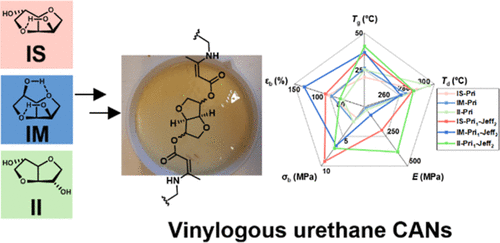异己体立体化学对乙烯基聚氨酯共价适应性网络的影响
IF 5.2
1区 化学
Q1 POLYMER SCIENCE
引用次数: 0
摘要
淀粉衍生的异己体具有两个顺式四氢呋喃环的独特结构,已被用于制备共价自适应网络(can),并定制和了解其结构-性能关系,以寻求取代油基热固性物。在这里,动态是通过乙烯基聚氨酯化学来实现的,刚性是通过使用淀粉衍生的异构体构建块异山梨酯、异甘油酯和异甘油酯来实现的,灵活性是通过使用胺来实现的。与热塑性塑料类似,根据所选择的异构体,热稳定性和机械性能可以在一定程度上进行调整。交联之间的距离由所使用的胺决定,当这个距离足够长以允许足够的链迁移时,可以观察到立体化学对机械性能的影响。CAN结构都显示热固性,并且由于结合了动态键,它们是机械可再加工的。基于can的结构设计,即异己异构体和胺结构,可获得抗拉强度(σb)为1.57 ~ 19.1 MPa,玻璃化转变温度(Tg)为20 ~ 114℃,热稳定性(Td,5%)为200 ~ 305℃。机械后处理得到了证实,经过两次后处理循环后,没有观察到机械性能的衰减。这为淀粉衍生构建块的can结构-性能关系提供了重要信息,因此,如何根据目标应用定制材料性能。本文章由计算机程序翻译,如有差异,请以英文原文为准。

Effects of Isohexide Stereochemistry on Vinylogous Urethane Covalent Adaptable Networks
The starch-derived isohexides, with their unique structures of two fused tetrahydrofuran rings in a cis conformation, have been exploited to prepare covalent adaptable networks (CANs) and to tailor and understand their structure–property relationships, in pursuit of replacing oil-based thermosets. Here, dynamicity was achieved through vinylogous urethane chemistry, rigidity via the use of the starch-derived isomeric building blocks isosorbide, isomannide, and isoidide, and flexibility through the amines utilized. Similar to what is known for thermoplastics, depending on the isomer chosen, thermal stability and mechanical properties could be tailored to some extent. The distance between cross-links was ruled by the amines employed, and when this distance was long enough to allow sufficient chain mobility, stereochemical effects on mechanical performance were observed. The CAN structures all display thermoset properties, and as a consequence of the incorporated dynamic bonds, they were mechanically reprocessable. Based on the CANs structural design, i.e., isohexide isomer and amine structure, tensile strengths (σb) ranging from 1.57 to 19.1 MPa, glass transition temperatures (Tg) ranging from 20 to 114 °C, and thermal stabilities (Td,5%) between 200 and 305 °C were achievable. Mechanical reprocessing was proven, and no mechanical performance decay was observed after two reprocessing cycles. This provides important information on the structure–property relationship of CANs from starch-derived building blocks, and consequently, how material properties can be tailored depending on the targeted application.
求助全文
通过发布文献求助,成功后即可免费获取论文全文。
去求助
来源期刊

Macromolecules
工程技术-高分子科学
CiteScore
9.30
自引率
16.40%
发文量
942
审稿时长
2 months
期刊介绍:
Macromolecules publishes original, fundamental, and impactful research on all aspects of polymer science. Topics of interest include synthesis (e.g., controlled polymerizations, polymerization catalysis, post polymerization modification, new monomer structures and polymer architectures, and polymerization mechanisms/kinetics analysis); phase behavior, thermodynamics, dynamic, and ordering/disordering phenomena (e.g., self-assembly, gelation, crystallization, solution/melt/solid-state characteristics); structure and properties (e.g., mechanical and rheological properties, surface/interfacial characteristics, electronic and transport properties); new state of the art characterization (e.g., spectroscopy, scattering, microscopy, rheology), simulation (e.g., Monte Carlo, molecular dynamics, multi-scale/coarse-grained modeling), and theoretical methods. Renewable/sustainable polymers, polymer networks, responsive polymers, electro-, magneto- and opto-active macromolecules, inorganic polymers, charge-transporting polymers (ion-containing, semiconducting, and conducting), nanostructured polymers, and polymer composites are also of interest. Typical papers published in Macromolecules showcase important and innovative concepts, experimental methods/observations, and theoretical/computational approaches that demonstrate a fundamental advance in the understanding of polymers.
 求助内容:
求助内容: 应助结果提醒方式:
应助结果提醒方式:


